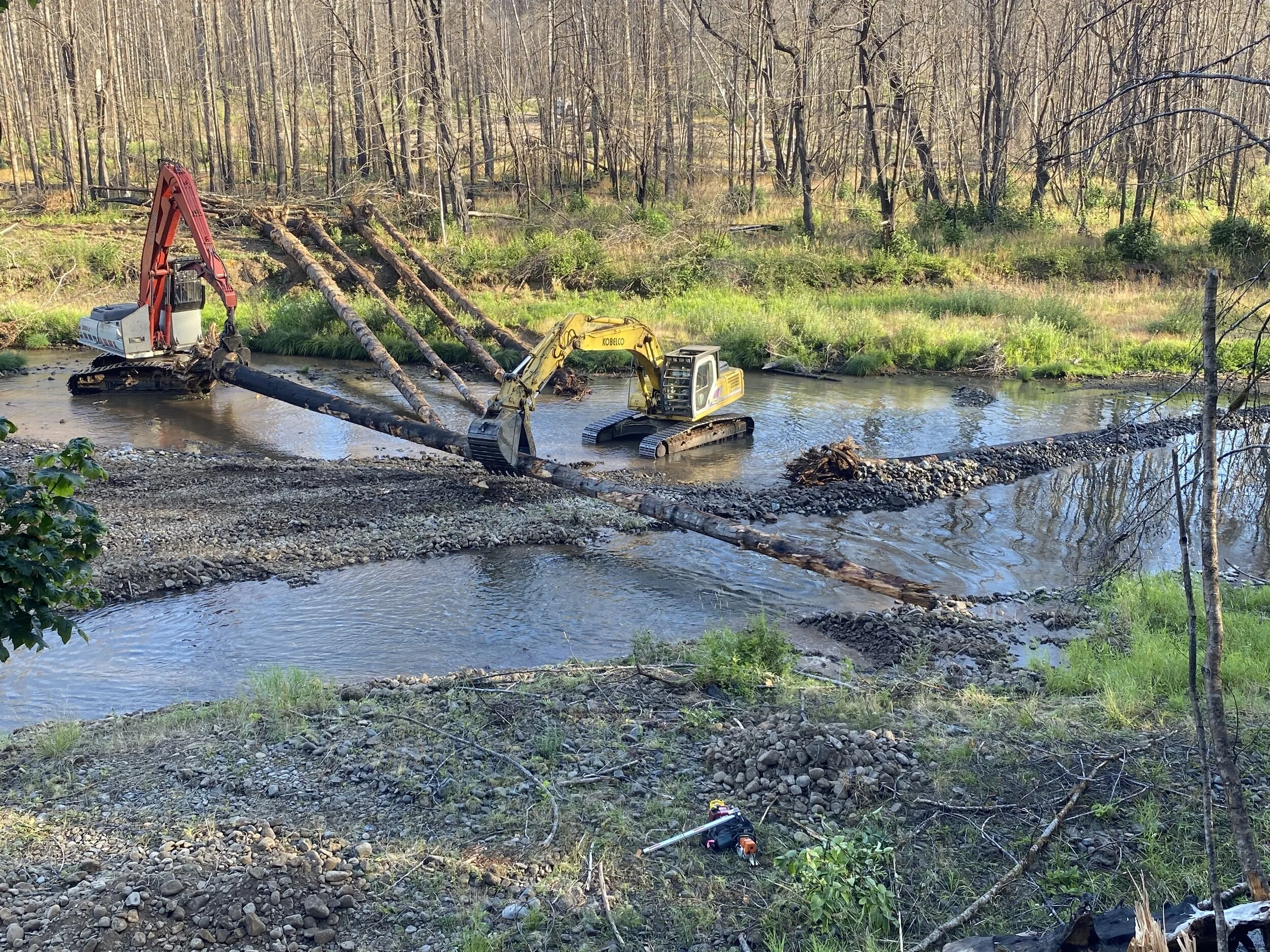Current Projects and Projects Under Development
Rock Creek Restoration - Archie Creek Fire Recovery
The Rock Creek watershed has the potential to be one of the most productive watersheds for salmonids in the North Umpqua Basin due to its extensive floodplain network and diversity of salmonids. Unfortunately, due to past practices the streams in the watershed are now largely disconnected from their floodplains. Floodplains with active side channels are one of the most important habitat features for salmonid production, fish survival, and watershed health. Rock Creek is home to Chinook and coho salmon, steelhead, cutthroat trout, and Pacific lamprey.
In September of 2020, the Archie Creek fire burned over 130,000 acres in the North Umpqua including over 70% of the Rock Creek watershed. The fire accelerated the need for restoration work with a need to capture post-fire substrate and woody material, as well as provide cold water refugia to salmonids until riparian vegetation can recover.
Our goals are to:
Restore and maximize natural production of Chinook and coho salmon, steelhead, cutthroat trout, and Pacific lamprey within Rock Creek.
Restore channel hydrology and reconnect stream channels to associated floodplains
Restore, rehabilitate, and maximize aquatic habitat. Improve water quality in restored stream reaches.
Glover Estuary Enhancement
Many estuarine wetlands along the coast have been filled, cleared, diked and drained for agriculture or urban development. Tidal wetlands along the lower Smith River were converted to pastures on 135 acres of the Glover Ranch by building levees, reconfiguring stream channels to ditches and installing tidegates to control the incoming tide. Partnership for the Umpqua Rivers (PUR), Umpqua Soil and Water Conservation District (USWCD), Oregon Department of Fish and Wildlife (ODFW), Natural Resources Conservation Service (NRCS), National Marine Fisheries Service (NMFS) and the Glover Family are collaborating to complete fish passage, tidal channel work and livestock management needed to improve ecological conditions in the Umpqua Estuary. During 2020, two failing tidegates will be replaced and retrofitted to increase fish passage, tidal channels will be expanded and/or rebuilt, livestock management fencing and complimentary off-channel water systems will be built, low water fords will be replaced with bridges and tidal channels will be enhanced with native plantings. Muted Tide Regulators will be adjusted at each tidegate to provide 30 flooded acres at each high tide during the winter season and 15 acres during high tides occurring in the summer. Approximately 5.38 miles of livestock fence is proposed to be built 20’ from the channel, and over 5,300 native plants will be established along the tidal channels. This project is located in the tidal wetlands of the Umpqua River Estuary, an area important to ESA listed Oregon Coast coho and eulachon, Chinook salmon, steelhead trout, Pacific lamprey and a variety of other native fish.
Olalla Creek Tributaries Fish Passage and Instream Enhancement
Olalla Creek and three tributaries, located in the southern part of the 103,000-acre Olalla-Lookingglass Creek Watershed, need improved fish passage and fish habitat enhancement. During 2022, Bureau of Land Management (BLM) and Oregon Department of Fish and Wildlife (ODFW) funds will be spent to replace two failing culverts that block fish passage into two of the tributaries. OWEB funds will be spent in summer 2023 to fund instream and riparian habitat enhancement in an adjacent tributary. This project is a high priority for this region because of the fisheries values it offers, positive impact it will have on local business owners and the opportunity to recruit other landowners for future projects. According to ODFW High Intrinsic Potential (HIP) maps, Olalla, Byron and Bushnell creeks have high potential to provide quality spawning and rearing habitat for coho salmon and steelhead, but currently have low quality habitat and poor fish passage. Old Lane Creek was not modeled for HIP but is surveyed for salmon and steelhead spawning. Our project partners, ODFW, BLM and the Byron Creek Estates worked together on a technical assistance project that resulted in designs for the culverts, instream enhancement and riparian work. ODFW views this project as a high priority and funded the gap needed for the culvert replacements.
Yellow Creek Instream Restoration
Yellow Creek, located South of Elkton, Oregon, flows through a patchwork of private timber and Bureau of Land Management (BLM) property. The Partnership for the Umpqua Rivers (PUR), Roseburg District BLM, Oregon Department of Fish and Wildlife (ODFW), Roseburg Resources Company (RRCo) and Lone Rock Timberland (LRT) are working together to restore the Yellow Creek drainage to benefit Oregon Coast (OC) Coho salmon, steelhead, cutthroat trout and other various aquatic species. According to ODFW High Intrinsic Maps, Yellow Creek has highest, higher and medium potential areas throughout it and its major tributaries (Bear Creek and Doe Creek). In 2005 PUR and BLM placed structures in the lower reaches of Yellow Creek and in the upper reaches of Bear Creek. We have grown and understand more since this project has been completed and want to design for untreated reaches of the Yellow Creek drainage. The untreated reaches of all three creeks lack large wood and their habitat is simple and lacking in complexity. This project has become a priority for PUR not only because of the amount of potential habitat we could create, but because BLM is doing a nearby timber sale and we plan to take advantage of being able to source wood from so close.

































